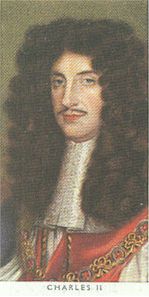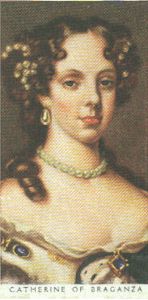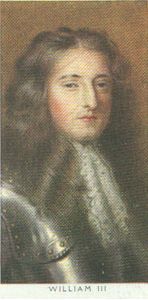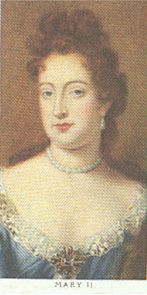Our Territories
Channel Islands
England
Ireland
Isle of Man
Scotland
Wales
Our Categories
Home | Set 1 | Set 2 | Set 3 | Set 4 | Set 5 | Set 6 | Set 7 | Set 8 | Set 9 | Set 10
 |
Charles II Son of Charles I and Henrietta Maria of France. His adolescence and early manhood were spent in civil war, defeat, exile and poverty. Jubilantly restored in 1660 to his throne, he returned cynical and mistrustful. Though lazy, he was skilled in foreign affairs and, seeing Holland as England's chief rival, made a secret alliance with France. With a strong taste for science and architecture he combined perception and wit above the ordinary, but was fatally unwilling to face unpleasant issues, finding intrigue easier. The "Merry Monarch" thought to escape from uncongenial burdens through his private amusements, but was disillusioned. |
 |
Catherine of
Braganza The daughter of King of Portugal, Catherine was married to Charles II in 1662. Uneducated and quite inexperienced, she had much difficulty in adapting herself to the manners of Whitehall and was deeply injured by the position of Lady Castlemaine. Soon realizing her own helplessness she became complaisant, playing her part with discretion and forbearance, though with excessive parsimony. There was a bond of strong affection between her and Charles, and his death grieved her deeply. She returned to Portugal, where she acted as Regent and, as a result of her economies, died immensely wealthy. |
 |
James II Brother of Charles II, his upbringing, like that of Charles, was haphazard, but his personal character was in most ways stronger. As Duke of York he was energetic in public affairs, capable and courageous in naval administration and command, and loyal to his brother. But his conversion to Roman Catholicism was unpopular in 17th-century England. His efforts to emancipate the Catholics and to restore England to Rome ended in Revolution, and the flight of himself and his family. James married (i) Anne Hyde (ii) Mary of Modena. He died in exile in 1701. |
 |
William III William of Orange, a grandson of Charles I, married Mary, a daughter of James II. When James was deposed, William and Mary were invited to become joint-sovereigns of England. William's ambition was to save the Netherlands from France and he welcomed the chance of bringing England into the European coalition against Louis XIV. A shy and retiring man, he made few English friends, though his statesmanship won respect; on the battlefield he displayed courage and genius. He died on the eve of war with France, and it was left to Marlborough to complete William's task. |
 |
Mary II James II's eldest daughter was brought up as a Protestant, and at fifteen married William of Orange. Mary's early life in Holland was lonely, but she became devoted to her husband. When her father's Catholicism led to his deposition Mary and her husband consented to succeed him. She proved a capable partner, presiding over the Council during William's absences. Mar's sweet nature was shocked by the coarseness of the Stuart court. She had all the Stuart intelligence, loved learning, and endowed William and Mary College, Virginia. Her early death was a sever blow to William-and to England. |
Home | Set 1 | Set 2 | Set 3 | Set 4 | Set 5 | Set 6 | Set 7 | Set 8 | Set 9 | Set 10